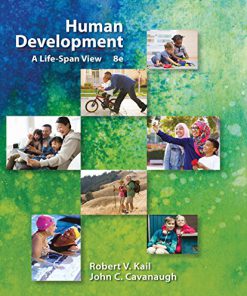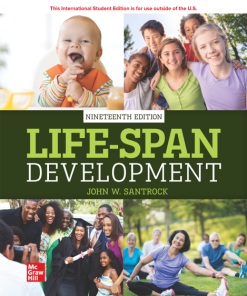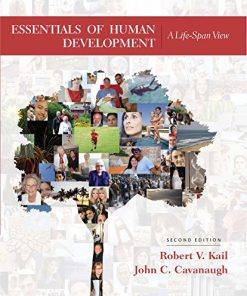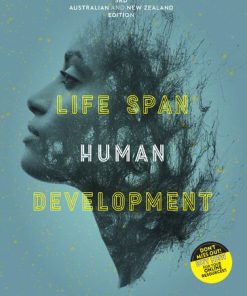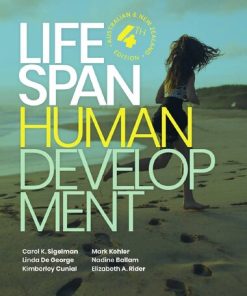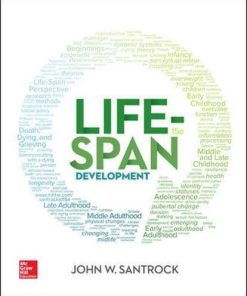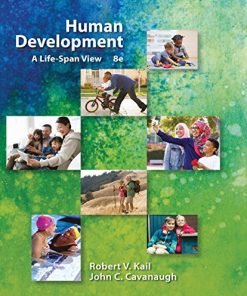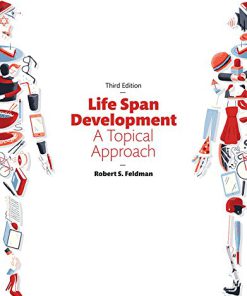Human Development A Life Span View 8th Edition by Robert Kail 9798214345444
$50.00 Original price was: $50.00.$25.00Current price is: $25.00.
Human Development: A Life-Span View 8th Edition by Robert V. Kail – Ebook PDF Instant Download/DeliveryISBN: 9798214345444
Full download Human Development: A Life-Span View 8th Edition after payment.
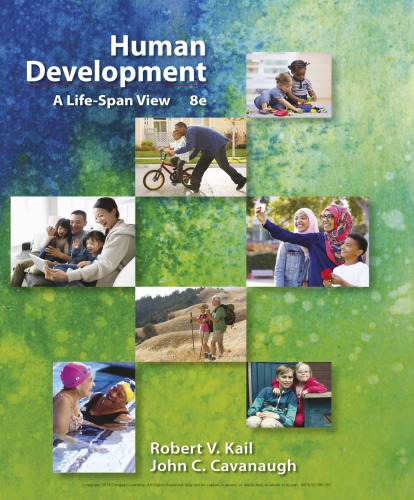
Product details:
ISBN-13 : 9798214345444
Author : Robert V. Kail
Feel intimidated by the life-span course? You’re in good hands with HUMAN DEVELOPMENT: A LIFE-SPAN VIEW, 8th Edition, as your guide. Complete, yet succinct and filled with real-life examples that aid understanding, the text has proven its ability to capture students’ interest while introducing them to the issues, forces, and outcomes that make us who we are. The efficient organization (chronological, but with a few chapters on key topical issues) allows this text to be briefer than many other texts for the same course. The material is relevant, too: You’ll gain the foundations in important theories and research that enable you to become an educated interpreter of developmental information in your future career. In addition, basic and applied research along with controversial topics and emergent trends demonstrate connections between the laboratory and life.
Human Development: A Life-Span View 8th Table of contents:
1. The Study of Human Development
1.1. Thinking About Development
Recurring Issues in Human Development
Basic Forces in Human Development: The Biopsychosocial Framework
Neuroscience: A Window Into Human Development
1.2. Developmental Theories
Psychodynamic Theory
Learning Theory
Cognitive-Developmental Theory
The Ecological and Systems Approach
Life-Span Perspective, Selective Optimization with Compensation, and Life-Course Perspective
The Big Picture
1.3. Doing Developmental Research
Measurement in Human Development Research
General Designs for Research
Designs for Studying Development
Integrating Findings from Different Studies
Conducting Research Ethically
Communicating Research Results
Applying Research Results: Social Policy
Summary
Key Terms
2. Biological Foundations: Heredity, Prenatal Development, and Birth
2.1. In the Beginning: 23 Pairs of Chromosomes
Mechanisms of Heredity
Genetic Disorders
Heredity, Environment, and Development
2.2. From Conception to Birth
Period of the Zygote (Weeks 1–2)
Period of the Embryo (Weeks 3–8)
Period of the Fetus (Weeks 9–38)
2.3. Influences on Prenatal Development
General Risk Factors
Teratogens: Drugs, Diseases, and Environmental Hazards
Drugs
How Teratogens Influence Prenatal Development
Prenatal Diagnosis and Treatment
2.4. Labor and Delivery
Stages of Labor
Approaches to Childbirth
Adjusting to Parenthood
Birth Complications
Infant Mortality
Summary
Key Terms
3. Tools for Exploring the World
3.1. The Newborn
The Newborn’s Reflexes
Assessing the Newborn
The Newborn’s States
Temperament
3.2. Physical Development
Growth of the Body
The Emerging Nervous System
3.3. Moving and Grasping: Early Motor Skills
Locomotion
Fine Motor Skills
3.4. Coming to Know the World: Perception
Smell, Taste, and Touch
Hearing
Seeing
Integrating Sensory Information
3.5. Becoming Self-Aware
Origins of Self-Concept
Theory of Mind
Summary
Key Terms
4. The Emergence of Thought and Language
4.1. The Onset of Thinking: Piaget’s Account
Basic Principles of Cognitive Development
Sensorimotor Thinking
Preoperational Thinking
Appearance as Reality
Evaluating Piaget’s Theory
Extending Piaget’s Account: Children’s Naïve Theories
4.2. Information Processing During Infancy and Early Childhood
General Principles of Information Processing
Attention
Learning
Memory
Learning Number Skills
4.3. Mind and Culture: Vygotsky’s Theory
The Zone of Proximal Development
Scaffolding
Private Speech
4.4. Language
The Road to Speech
First Words and Many More
Speaking in Sentences: Grammatical Development
Communicating with Others
Summary
Key Terms
5. Entering the Social World
5.1. Beginnings: Trust and Attachment
Erikson’s Stages of Early Psychosocial Development
The Growth of Attachment
What Determines Quality of Attachment?
Attachment, Work, and Alternative Caregiving
5.2. Emerging Emotions
The Function of Emotions
Experiencing and Expressing Emotions
Recognizing and Using Others’ Emotions
Regulating Emotions
5.3. Interacting with Others
The Joys of Play
Helping Others
5.4. Gender Roles and Gender Identity
Images of Men and Women: Facts and Fantasy
Gender Typing
Evolving Gender Roles
Summary
Key Terms
6. Off to School
6.1. Cognitive Development
More Sophisticated Thinking: Piaget’s Version
Information-Processing Strategies for Learning and Remembering
Aptitudes for School
Theories of Intelligence
Binet and the Development of Intelligence Testing
Do Tests Work?
Hereditary and Environmental Factors
The Impact of Ethnicity and Socioeconomic Status
6.3. Special Children, Special Needs
Gifted Children
Children with Disability
Attention-Deficit Hyperactivity Disorder
6.4. Academic Skills
Reading
Writing
Math Skills
Effective Schools, Effective Teachers
6.5. Physical Development
Growth
Development of Motor Skills
Physical Fitness
Participating in Sports
Summary
Key Terms
7. Expanding Social Horizons
7.1. Family Relationships
The Family as a System
Dimensions and Styles of Parenting
Siblings
Divorce and Remarriage
Parent–Child Relationships Gone Awry: Child Maltreatment
7.2. Peers
Friendships
Groups
Popularity and Rejection
Aggressive Children and Their Victims
7.3. Electronic Media
Television Programs
Video Games
Social Media
7.4. Understanding Others
Describing Others
Understanding What Others Think
Prejudice
Summary
Key Terms
8. Rites of Passage
8.1. Pubertal Changes
Signs of Physical Maturation
Mechanisms of Maturation
Psychological Impact of Puberty
8.2. Health
Nutrition
Physical Fitness
Threats to Adolescent Well-Being
8.3. Information Processing During Adolescence
Working Memory and Processing Speed
Content Knowledge, Strategies, and Metacognitive Skill
Problem-Solving and Reasoning
8.4. Reasoning About Moral Issues
Kohlberg’s Theory
Evaluating Kohlberg’s Theory
Promoting Moral Reasoning
Summary
Key Terms
9. Moving into the Adult Social World
9.1. Identity and Self-Esteem
The Search for Identity
Ethnic Identity
Self-Esteem in Adolescence
The Myth of Storm and Stress
9.2. Romantic Relationships and Sexuality
Romantic Relationships
Sexual Behavior
Sexual Minority Youth
Dating Violence
9.3. The World of Work
Career Development
Part-Time Employment
9.4. The Dark Side
Drug Use
Depression
Delinquency
Summary
Key Terms
10. Becoming an Adult
10.1. Emerging Adulthood
Role Transitions Marking Adulthood
Neuroscience, Behavior, and Emerging Adulthood
Achieving Milestones: Education, Workforce, and Erikson’s Intimacy
So When Do People Become Adults?
10.2. Physical Development and Health
Growth, Strength, and Physical Functioning
Lifestyle Factors in Health
10.3. Cognitive Development
How Should We View Intelligence in Adults?
Primary and Secondary Mental Abilities
Fluid and Crystallized Intelligence
Neuroscience Research and Intelligence
Going Beyond Formal Operations: Thinking in Adulthood
Integrating Emotion and Logic in Emerging and Young Adulthood
10.4. Who Do You Want to Be? Personality in Young Adulthood
Creating Life Stories
Possible Selves
Personal Control Beliefs
Summary
Key Terms
11. Being with Others: Relationships in Young and Middle Adulthood
11.1. Relationship Types and Issues
Friendships
Love Relationships
Violence in Relationships
11.2. Lifestyles and Relationships
Singlehood
Cohabitation
LGBTQ Relationships
Marriage
11.3. Family Dynamics and the Life Course
The Parental Role
Diverse Family Forms
11.4. Divorce and Remarriage
Divorce
Remarriage
Summary
Key Terms
12. Working and Relaxing
12.1. Occupational Selection and Development
The Meaning of Work
Occupational Choice Revisited
Occupational Development
Job Satisfaction
12.2. Gender, Ethnicity, and Discrimination Issues
Gender Differences in Occupational Selection
Women and Occupational Development
Ethnicity and Occupational Development
Bias and Discrimination
Gender Bias, Glass Ceilings, and Glass Cliffs
12.3. Occupational Transitions
Retraining Workers
Occupational Insecurity
Coping with Unemployment
12.4. Work and Family
The Dependent Care Dilemma
Juggling Multiple Roles
12.5. Taking Time to Relax: Leisure Activities
Types of Leisure Activities
Developmental Changes in Leisure
Consequences of Leisure Activities
Summary
Key Terms
13. Making It in Midlife
13.1. Physical Changes and Health
Changes in Appearance
Changes in Bones and Joints
Reproductive Changes
Stress and Health
Exercise
13.2. Cognitive Development
Practical Intelligence
Becoming an Expert
Lifelong Learning
13.3. Personality
The Five-Factor Trait Model
Changing Priorities in Midlife
13.4. Family Dynamics and Middle Age
Letting Go: Middle-Aged Adults and Their Children
Giving Back: Middle-Aged Adults and Their Aging Parents
Grandparenthood
Summary
Key Terms
14. The Personal Context of Later Life
14.1. What Are Older Adults Like?
The Demographics of Aging
Longevity
The Third–Fourth Age Distinction
The “Good News”: The Third Age (Young-Old)
14.2 Physical Changes and Health
Biological Theories of Aging
Physiological Changes
Chronic Disease and Lifestyle Health Issues
14.3. Cognitive Processes
Information Processing
Memory
Creativity and Wisdom
14.4. Mental Health and Intervention
Depression
Anxiety Disorders
Dementia
Summary
Key Terms
15. Social Aspects of Later Life Psychosocial, Retirement, Relationship, and Societal Issues
15.1. Theories of Psychosocial Aging
The Goal of Healthy Aging
Competence and Environmental Press
Preventive and Corrective Proactivity Model
15.2. Personality, Social Cognition, and Spirituality
Integrity Versus Despair
Well-Being and Emotion
Spirituality in Later Life
15.3. I Used to Work at . . . : Living in Retirement
What Does Being Retired Mean?
Why Do People Retire?
Adjustment to Retirement
Employment and Volunteering
15.4. Friends and Family in Late Life
Friends, Siblings, and Socioemotional Selectivity
Marriage and Same-Sex Partnerships
Caring for a Partner
Widowhood
Great-Grandparenthood
15.5. Social Issues and Aging
Frail Older Adults
Housing Options
Elder Abuse and Neglect
Social Security and Medicare
Summary
Key Terms
16. Dying and Bereavement
16.1. Definitions and Ethical Issues
Sociocultural Definitions of Death
Legal and Medical Definitions
Ethical Issues
16.2. Thinking About Death: Personal Aspects
A Life-Course Approach to Dying
Dealing with One’s Own Death
Death Anxiety
16.3. End-of-Life Issues
Creating a Final Scenario
The Hospice Option
Making Your End-of-Life Intentions Known
16.4. Surviving the Loss: The Grieving Process
The Grief Process
Typical Grief Reactions
Coping With Grief
Ambiguous Loss
Complicated or Prolonged Grief Disorder
Disenfranchised Grief
16.5. Dying and Bereavement Experiences Across the Life Span
Childhood
Adolescence
Adulthood
Late Adulthood
People also search for Human Development: A Life-Span View 8th:
essentials of human development a life span view pdf
human development a life-span view 9th edition
human development a life-span view 9th edition pdf free
human development a life-span view 9th edition pdf
human development a life-span view pdf
Tags:
Human Development,Life Span,Robert Kail,efficient organization
You may also like…
Politics & Philosophy - Social Sciences
Psychology - Social Psychology
Politics & Philosophy - Social Sciences
Uncategorized




